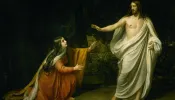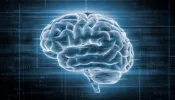For He has looked upon His handmaid's lowliness; behold, from now on will all ages call me blessed. The Mighty One has done great things for me, and holy is His name. Luke 1:48-49
The doctrine of the Immaculate Conception is one of the most difficult doctrines for non-Catholics to accept. It is most often misunderstood. It is sometimes confused with the virginal conception of Jesus. Some see it as glorifying Mary to the level of a goddess. Others believe that it contradicts the Bible. Still others claim it to be a human doctrine, since Pope Pius IX defined it as late as 1854.
According to the Catechism of the Catholic Church (CCC):
Through the centuries the Church has become ever more aware that Mary, "full of grace" (Luke 1:28) through God, was redeemed from the moment of her conception. That is what the dogma of the Immaculate Conception confesses, as Pope Pius IX proclaimed in 1854: "The most Blessed Virgin Mary was, from the first moment of her conception, by a singular grace and privilege of almighty God and by virtue of the merits of Jesus Christ, Savior of the human race, preserved immune from all stain of original sin." [CCC 491]
God calls us to become His adopted children and sharers in eternal life (Rom. 8:12-25). Grace is the free, undeserved help that God gives us to respond to His call (CCC 1996; 1 Cor. 15:10). In particular, sanctifying grace is a gift from God that perfects our soul so that we may live with Him and act by His love (CCC 2000; Titus 3:7). Sin, on the other hand, is our rejection of God and His call through willful disobedience (CCC 386; Rom. 6:11-23), while original sin is our original loss of sanctifying grace due to Adam's sin (CCC 396-421; Rom. 5:12-21). Mary's Immaculate Conception is a special gift from God preserving her from original sin and concupiscence - the inclination to sin. Mary always had sanctifying grace. By God's grace, she remained free of every personal sin all her life (CCC 493).
Some Christians may claim that this doctrine makes Mary into a god. Somehow these people confuse sinlessness with divinity. Adam and Eve were human creatures but sinless before the Fall. Ironically Adam's sin was an attempt to become a god (Gen. 3:5). Also the angels in heaven are only creatures yet sinless (2 Peter 2:4). In the same manner, Mary's gift does not make her divine, but allows her always to respond to God's call.
Others claim that Mary, if truly sinless, would not need a Savior. Yet in her Magnificat, Mary admits that God was her Savior (Luke 1:47). Now according to this doctrine, Mary was saved by anticipation and not by forgiveness. We are saved by forgiveness, since we sinned. But by anticipating the merits of Christ, God saved Mary before she fell in the mire of sin. As an example, a child can be saved from drowning after he falls into a swimming pool. He also could be saved from drowning by grabbing him before he falls in the pool. Our redemption is "healing medicine," but her redemption was like a "vaccine." She was always immune from sin, even venial sin (CCC 493). This is the most perfect kind of redemption.
Some may cite Romans 3:23, "all have sinned" [RSV] against this doctrine. Now "all" need not include absolutely everyone. Obviously Jesus (1 Peter 2:22) is not included. Also Romans 3:24 would otherwise imply that absolutely everyone will be justified, including unbelievers, so Hell would be empty. In the same passage, St. Paul writes that "none is righteous, no, not one" [Romans 3:10]. Yet elsewhere Noah, Daniel, Job (Ezek. 14:14,20), Zechariah and Elizabeth (Luke 1:6) are said to be righteous. St. Paul does not intend "absolutely everyone" but is stressing the universality of sin for both Jews and Gentiles. Even though this verse applies to us, it does not apply to Jesus or Mary. On a related issue, Mary makes a "sin offering" in Luke 2:24 to fulfill the Law. This duty does not prove her sinfulness but her obedience. Similarly Jesus underwent John's "baptism of repentance" even though sinless.
The main Bible text that suggests this doctrine is the Angel Gabriel's greeting to Mary:
"Hail, full of grace (kecharitomene), the Lord is with you!" [Luke 1:28, RSVCE]
The Greek word, kecharitomene, is the perfect passive participle of the Greek verb, charitoo, meaning to grace or favor. The perfect tense denotes completion or fullness. It can be translated as "completely graced" or "fully favored." St. Jerome in the 4th century translated it into Latin as, gratia plena, or "full of grace." Even some Protestant Bibles render it as "highly favored one" (NIV & KJV). In this verse Gabriel does not address her as "Hail, Mary" but as "Hail, full of grace." Gabriel uses this participle as a name or title for Mary. In Acts 6:8, St. Stephen is said to be "full of grace" according to the RSV, but this phrase is used as a description and not as a title. Mary is named "Full-of-Grace", which includes sanctifying grace. Grace is opposed to sin (Rom. 5:21). This verse may not prove the doctrine of the Immaculate Conception, but it would be an odd greeting otherwise. Elsewhere in the Bible, Elizabeth under the inspiration of the Holy Spirit declares to Mary:
"Blessed are you among women and blessed is the fruit of your womb!" [Luke 1:42, RSV; also see 48]
In this poetic parallel, Mary's blessing from God is compared to the blessing that rests on her Son - the fruit of her womb. Jesus was blessed in His humanity by being sinless (Hebrews 4:15) even while in her womb. Mary was blessed by God as the mother of His Son and in her freedom from sin.
The doctrine of the Immaculate Conception developed slowly through the centuries. Some divinely revealed truths take time for us to fully understand. Its development can be traced back to God's words to the serpent:
"I will put enmity between you (serpent) and the woman and between your seed and her seed; he shall bruise your head and you shall bruise his heel."[Genesis 3:15, RSV]
This verse is seen as the promise of the Redeemer. "He" and "her seed" refer to Christ. "Woman" and "her" can refer to Eve, but they apply better to Mary (John 19:26). Luke's Annunciation scene (Luke 1:26-38,42) appears to contrast the Eve-serpent scene (Gen. 3:1-7): Mary vs. Eve, Gabriel vs. Satan (Rev. 12:9) as serpent, Fruit of the womb vs. fruit of the tree. In Romans 5:14 and 1 Cor. 15:44-49, St. Paul sees Jesus Christ as the New Adam. In like fashion, St. Justin Martyr in 155 A.D. saw Mary as the New Eve: "For Eve, who was a virgin and undefiled, having conceived the word of the serpent, brought forth disobedience and death. But the Virgin Mary received faith and joy... And by her has He (Jesus) been born." [Dialogue with Trypho 100] St. Irenaeus in 190 A.D. wrote: "Eve was...the cause of death...; so also did Mary...become the cause of salvation, both to herself and the whole human race...The knot of Eve's disobedience was loosed by the obedience of Mary. For what the virgin Eve had bound fast through unbelief, this did the virgin Mary set free through faith." [Against Heresies III 22:4]
Jesus Christ as the New Adam corrected Adam's sin by His Cross, while Mary as the New Eve undid Eve's disobedience by saying yes to God (Luke 1:38). Around 360 A.D., St. Ephraem the Syrian was the first to clearly write on Mary's sinlessness. He saw Mary as a replica of Eve before the Fall: she "was as innocent as Eve before her fall, a virgin most estranged from every stain of sin, more holy than the Seraphim." The Church Fathers of the east also called Mary "the All-Holy" (Panagia) and proclaimed her as "free from any stain of sin, as though fashioned by the Holy Spirit and formed as a new creature" [CCC 493]. Unfortunately some people went too far, such as the Pelagian heretics who tried to use Mary to prove their "sinless conception."
This caused negative reactions. In the east, the feast of Mary's conception was already being celebrated by the 7th century. By the 12th century, it was clearly recognized that Mary, like Eve before the Fall, was sinless even at the first moments of her existence, i.e. at her conception. Gabriel's odd greeting (Luke 1:28) was starting to make more sense. St. Bernard and St. Thomas Aquinas had theological objections, but by the 14th century, John Duns Scotus resolved the objections. Finally in 1854, Pope Pius IX formally confirmed this ancient belief in precise language.
Mary is sinless by a special, unmerited gift of God and not by her own power. Even though we have free will, concupiscence inclines us to sin (Rom. 7:15-25), while Mary's gift inclined her towards God. Like us she needed redemption, but Almighty God redeemed her at conception by the anticipated merits of her Son. She did not have to be sinless because Jesus is sinless. So her mother did not need to be sinless and so on. God the Father simply gave Mary this singular privilege for being the mother of His only begotten Son (John 1:14,18). Nothing is impossible for God (Luke 1:37), Who is not limited by time. As the British monk, Eadmer reasoned: "God could do it; God should do it; so God did it."
Printed with permission from A Catholic Response, Inc.











